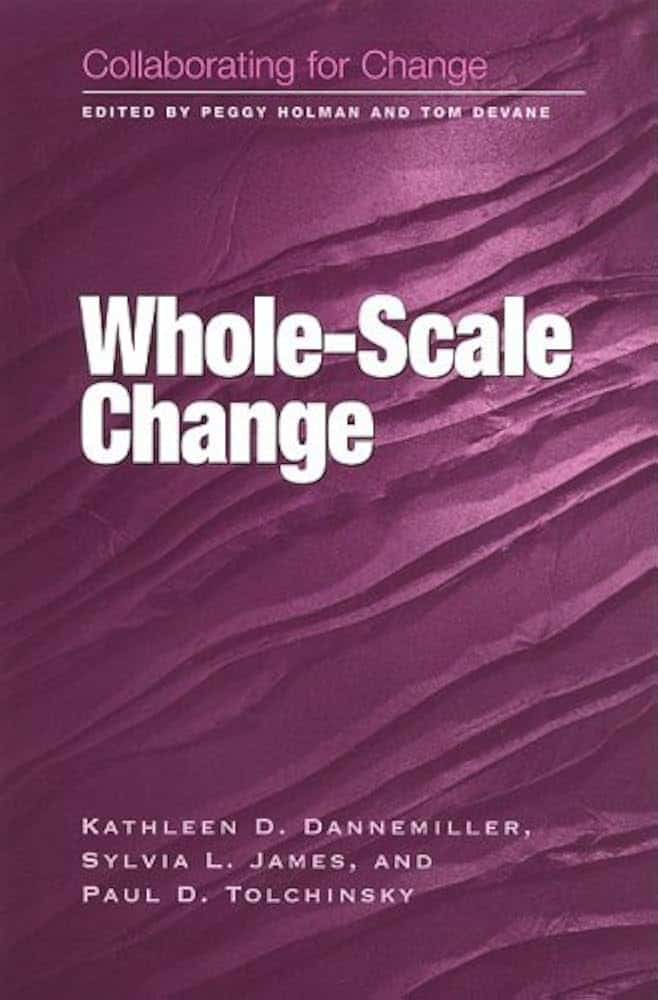What is important about this book
The authors of this text, aware of the ‘bad reputation’ that change processes have and of the fact that most of them fail by not creating value, have reworked their successful experiences in order to propose a simple, effective and scalable method of change management, applicable in both organisational and social contexts.
Whole-scale Change is a method that has been tested and validated by multiple experiences in the field, but it also has a consistent theoretical basis, which can be traced back to the approaches of Drucker, Schein, Argyris, Kolb, Deming, Capra and many others. This rich and solid theoretical background is matched by a clear, simple and operational approach. The Whole-Scale Change is driven by the will to “Uncovering and realizing combinend yearnings, hopes, longings, and inspirations” of all the elements involved in change processes.
For the successful management of a change project, there are 2 aspects to be strongly guarded:
1) Engage the people involved in the change, giving them all available information and creating a shared purpose;
2) Proceed in a systemic manner, without creating situations where one side wins and one loses.
The authors of this booklet are:
Kathleen D. Dannemiller is coinventor of the Real Time Strategic change approach and has been a passionate advocate of Whole-System Change for more than 30 years.
Sylvia L. James has worked as an internal and external consultant in large-scale change for 20 years, pioneering the Whole-Scale process in the aerospace industry in the early ‘80s.
Paul D. Tolchinsky, Ph.D., has been consulting to major companies in North America for the past 20 years. He has extensive experience in Whole-Scale Change: his particular expertise is in the design of new facilities, applying sociotechnical principles to organizations.
Quotes
- “As seen through the lens of history, change is inevitable”.
- “People are demanding a greater voice in running their own lives”.
- “Enough change efforts have failed to create plenty of cynicism over the past ten years”.
- “Whole-Scale processes provide a powerful way of working with the whole system to create and sustain change”.
- “Whole scale also enables a critical mass of the organization to create a new culture in the moment”.
- “Once the organization experiences the paradigm shift, people see the world differently”.
- “Clients help decide which element to address first, but the people in the organization need to address all […] elements […] if they want to achieve sustainable change”.
- “The Whole-Scale process is a never-ending one”.
- “Whole-Scale is cost effective because it enables an organizational paradigm shift to occur, and this shift produces fast results”.
- “Rapid Whole-Scale change costs less than traditional top-down cascade methods”.
- “It is essential to prepare senior management to function as a Leadership Team, capable of managing the change process. People yearn for effective leaders, and Whole-Scale processes make those leaders very visible”.
- “Empowering more people in the organization instills the power in the individuals to sustain the change process”.
Structure and contents of the book
The Whole-Scale consists of a series of small- and/ or large-group interactions that enable an organization to undergo a paradigm shift. It applies an action-learning approach, using Whole-Scale events as accelerators.
The design of change is summarized in the formula D x V x F > R, where D stands for people Dissatisfaction, V stands for Vision of the future, F for First steps and R for Resistance to be overcome. Operationally:
- one starts from the elements of dissatisfaction with the current situation
- a vision of the future (Vision) is co-constructed
- define the first step of this change (First step), creating consensus on its realization
- this leads to the creation of a drive so strong and powerful that it overcomes resistance to change (Resistance).
This approach, very different from the classic ‘As is versus To be’, allows for an infinite tension to change, which is planned step by step and allows for extreme flexibility and adaptability to the evolution of the context.
Instructions for reading this book
Whole-Scale was born in 1981 when Ford Motor Company, seeking to move its management culture from “command & control” to a more participative style, brought in Al Davenport, Bruce Gibb, Chuck Tyson, and Kathleen Dannemiller to design and facilitate the change. The method that emerged from this initial work has been used for nearly two decades and has helped hundreds of organizations. Although each situation is different, the basic direction of Whole-Scale is the same: to help organizations uncover and engage the combined knowledge, wisdom, and hearts of their people to meet the challenges of a changing world.
Whole-Scale works well to facilitate all kinds of change processes, in both the public and private sectors, is amenable to groups ranging in size from ten to several thousand, and can engage people from the top of the hierarchy down through the frontline staff. Organizations most likely to consider a Whole-Scale intervention are those that want to engage everyone or nearly everyone in re-creating their organizations (processes and structures) and those with a sense of urgency brought by a challenging and quickly changing environment.
The booklet is very short, gets straight to the point and has understandable and fluent writing, contains diagrams and formulas, and most importantly also gives us a concrete case study as an example. Very interesting, and always in an extremely concise form, is the indication of the main mistakes in managing change projects.
